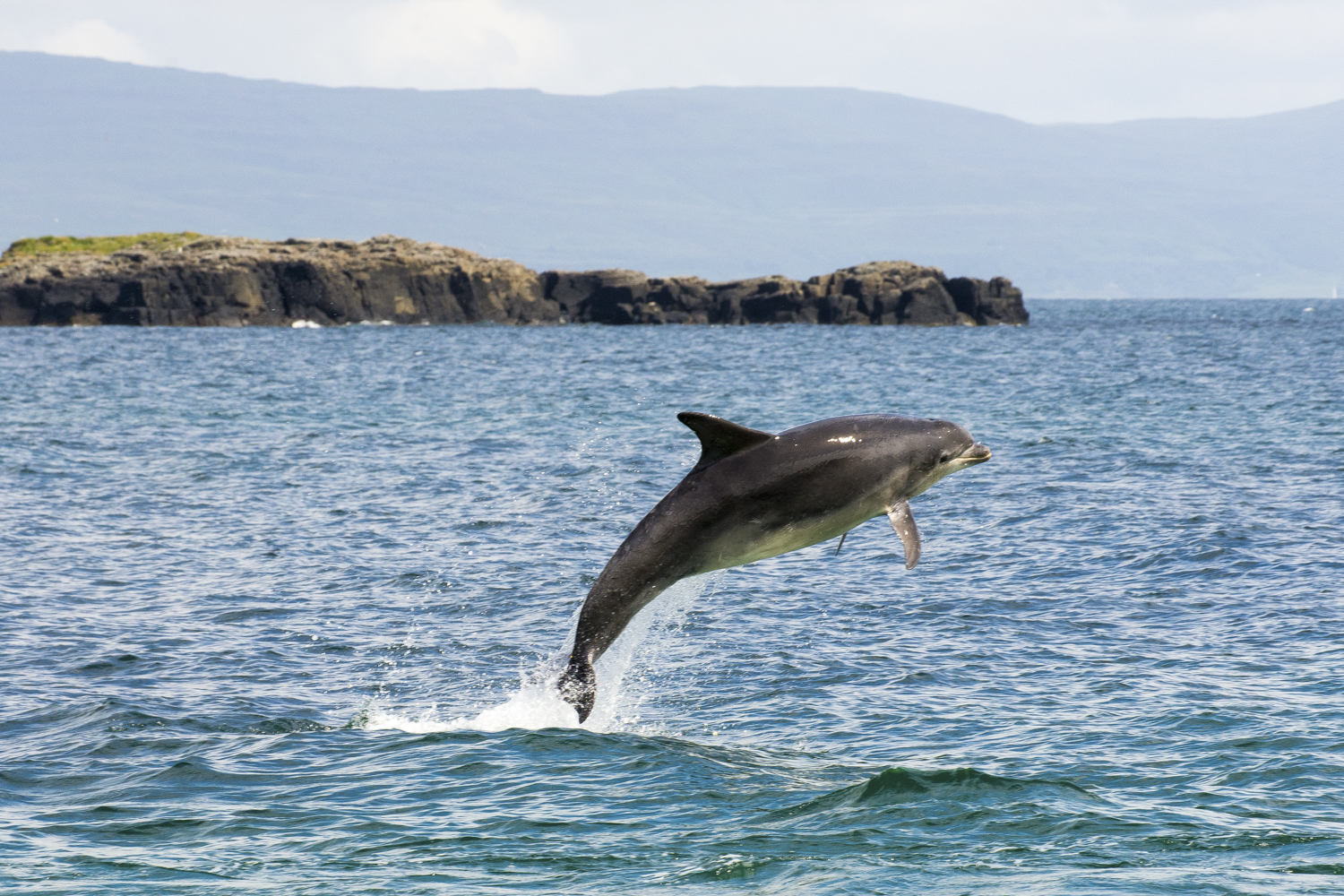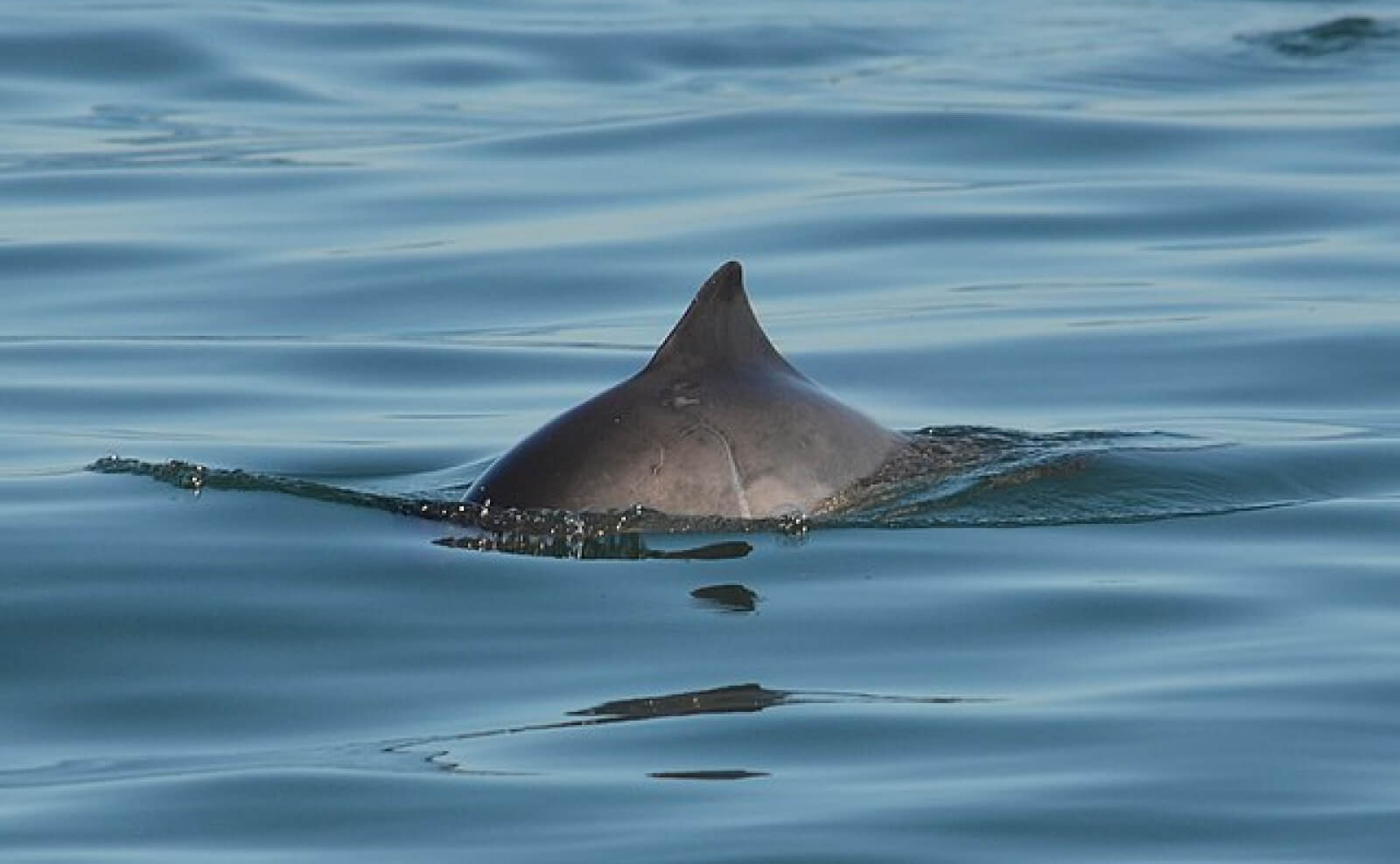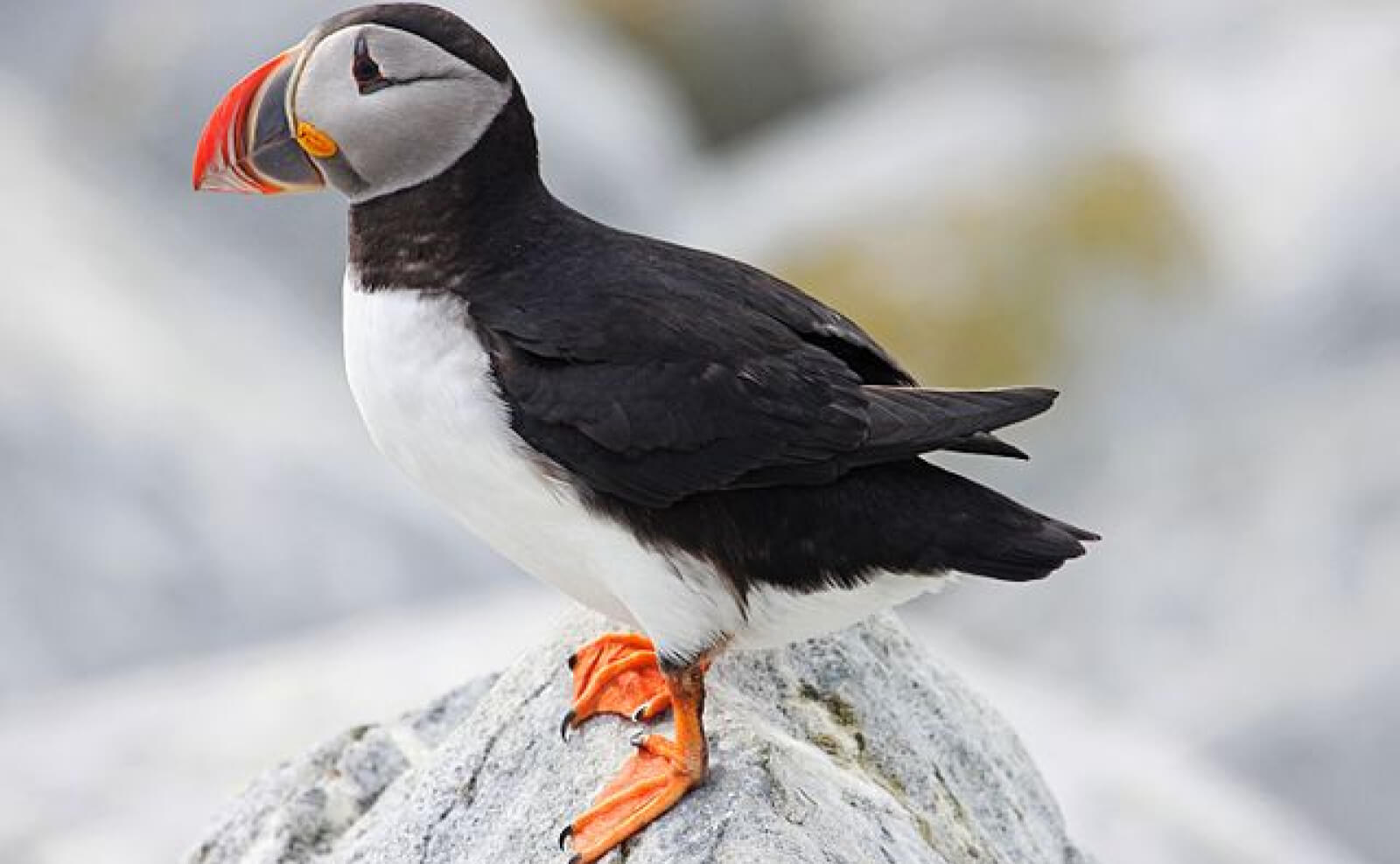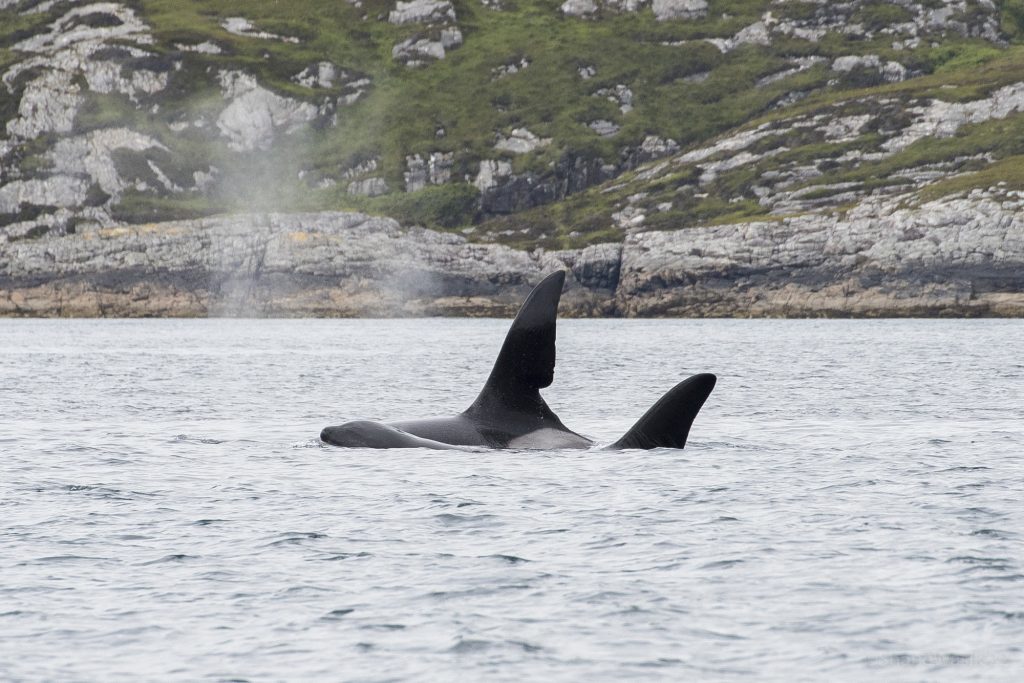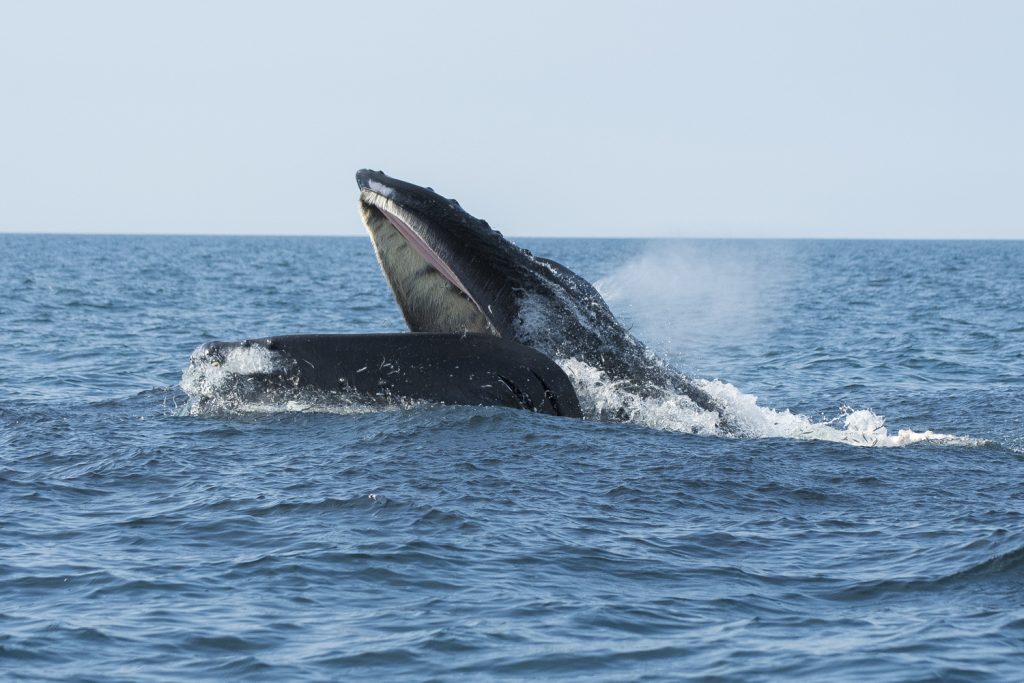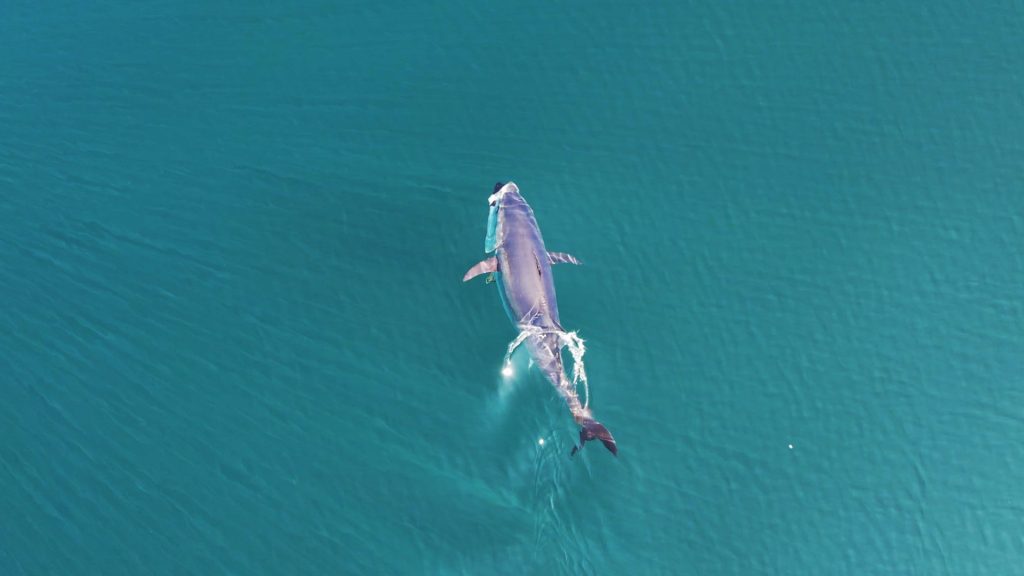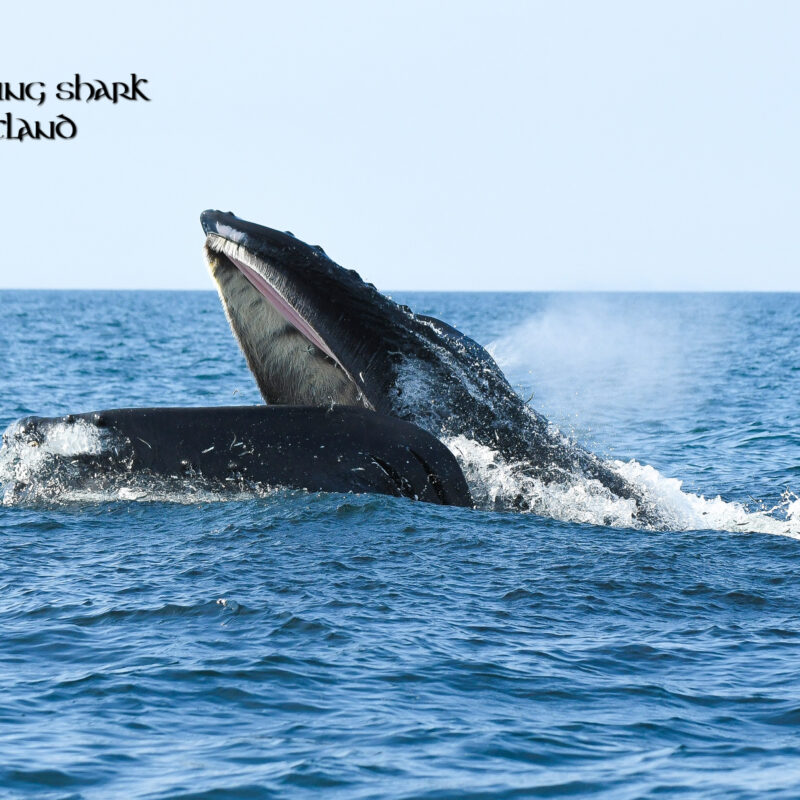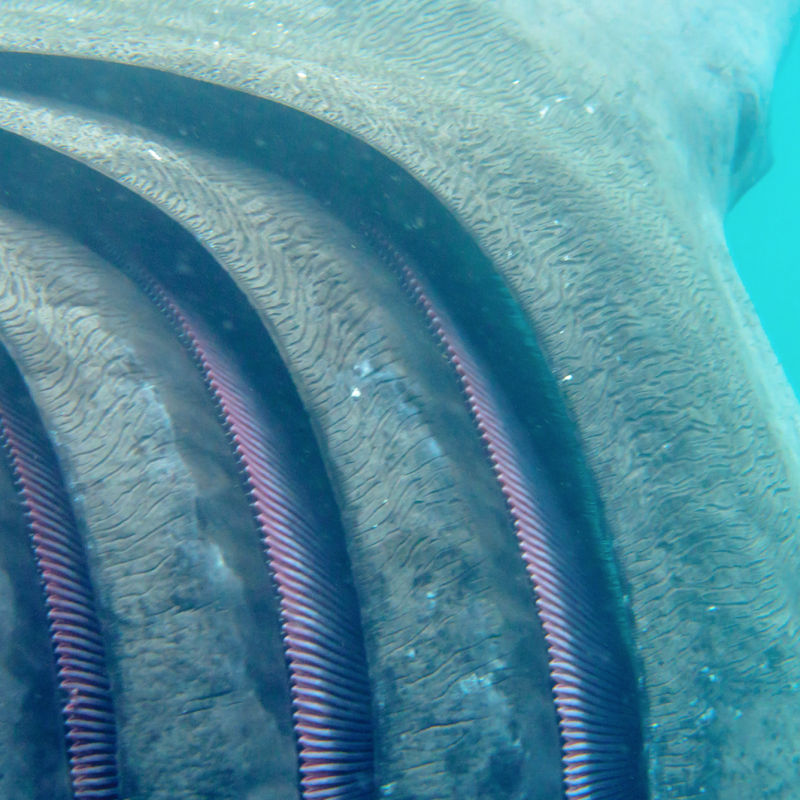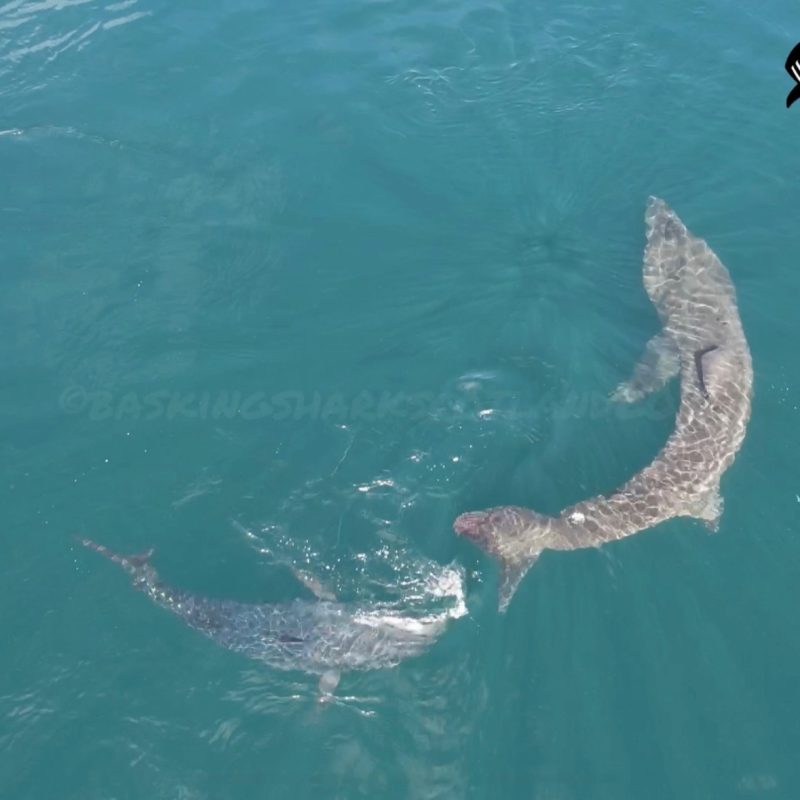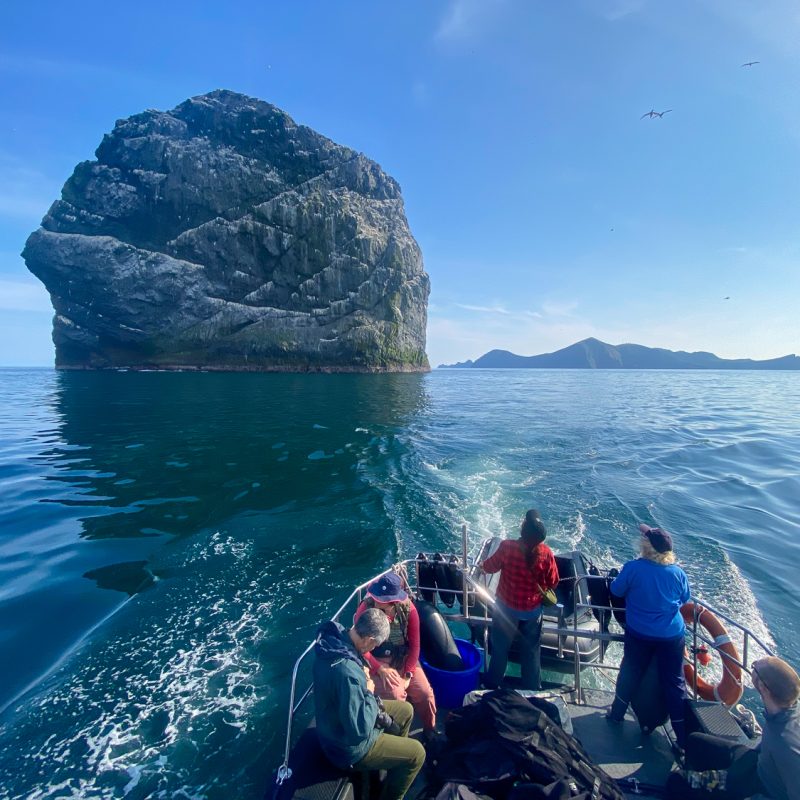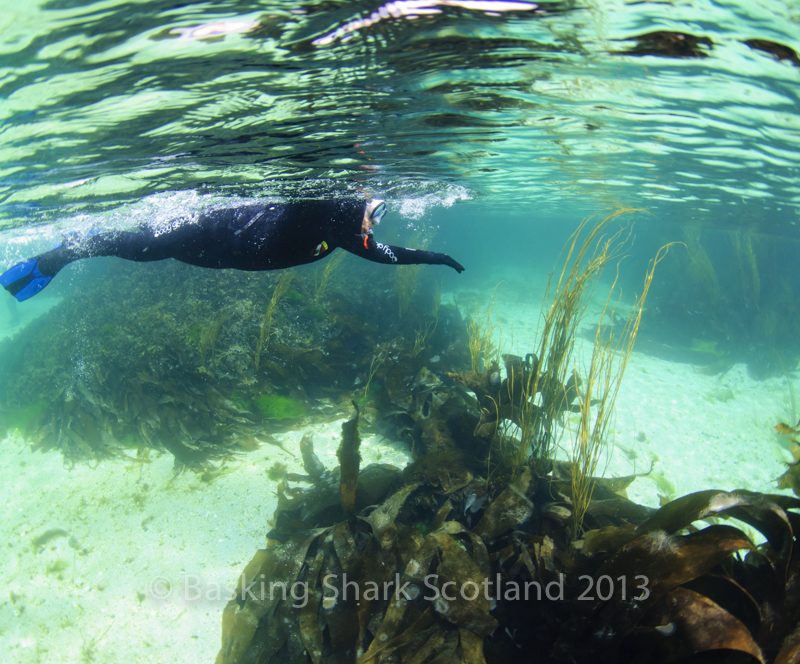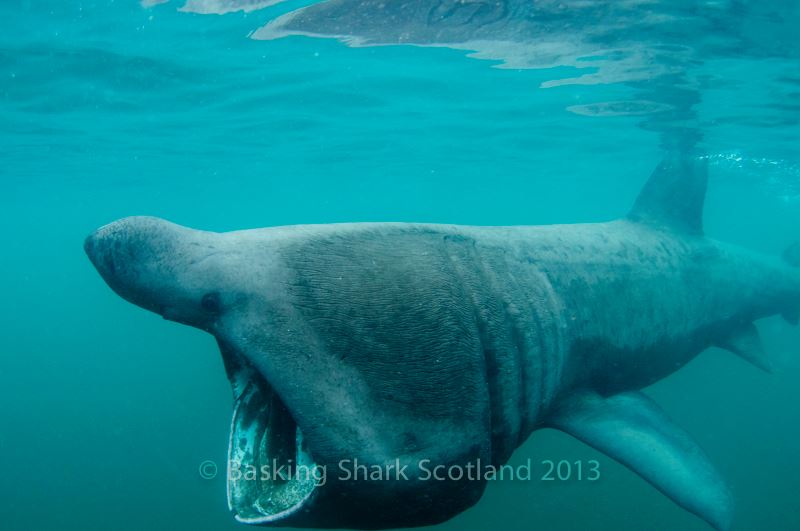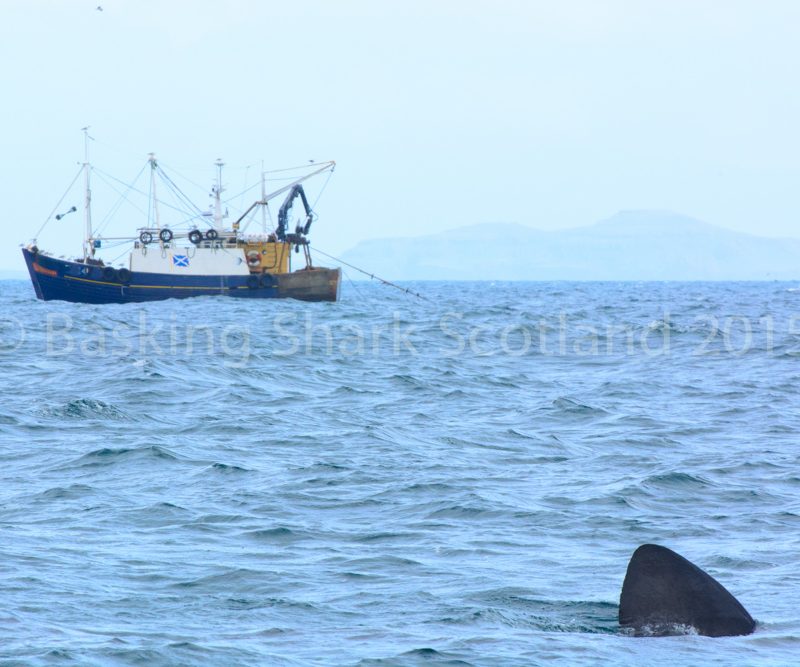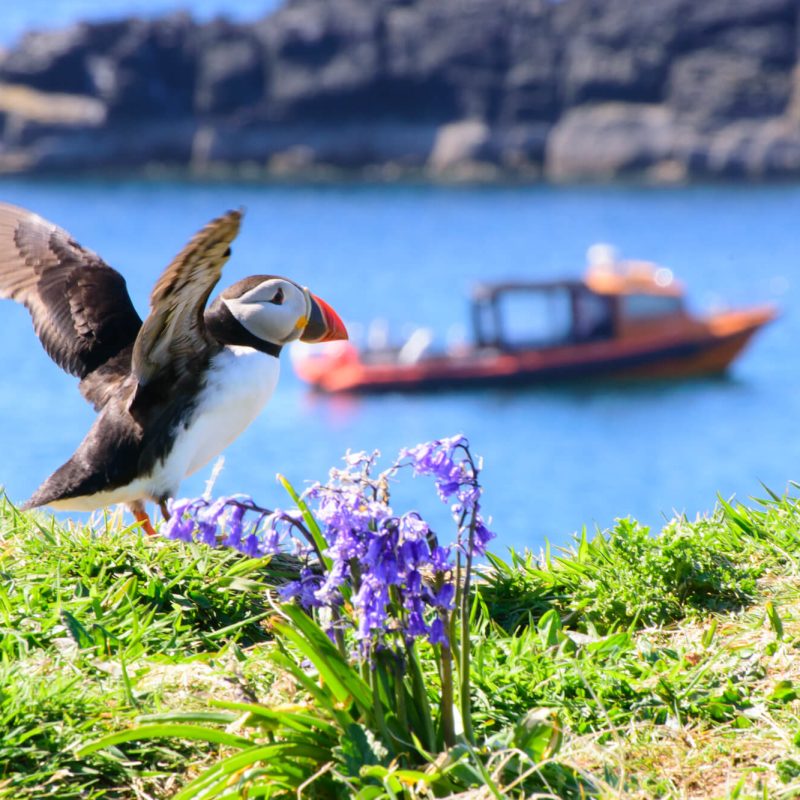
Hebrides
Wildlife Guide
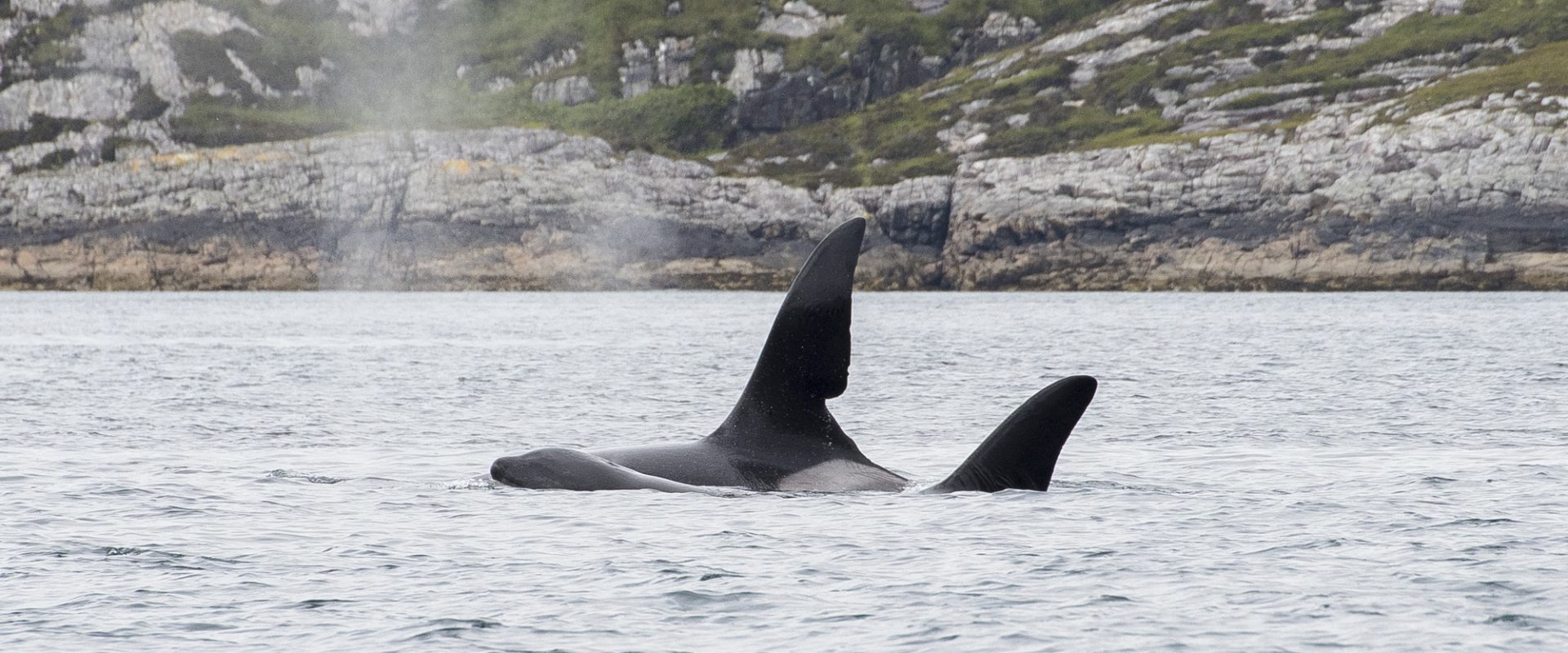
Basking shark
Cetorhinus maximus
Basking sharks are the second largest fish in the world, and the largest here in Scottish waters. They are slow moving, filter feeding sharks, feeding on a diet of only plankton. Whilst they are slow moving on the surface they can move faster, and do so to breach clean out of the water. They are the largest shark species to do so. Basking sharks are found globally in temperate seas, and aggregate in large numbers in the Hebrides. The area we search for basking sharks is the worlds first marine protected area for this species, recognised as a globally important hotspot. Basking sharks are classified as endangered on the IUCN red list of threatened species, for years we have been collecting data to help better understand the North Eastern Atlantic population of basking sharks.
Months to see: April – October (Peak season July – September)
Tours to see basking sharks:
For those who want to focus there trip on searching for basking sharks we recommend our 7 Day Basking Shark tours based from the Isle of Coll. These tours are scheduled at our peak time for basking shark sightings. If you haven’t got the time to spend 7 days at sea, we also offer 4 and 3 Day Basking Shark tours, and 1 Day Private Charters. We do occasionally see basking sharks during the spring, so one day of our spring & autumn island adventure tour is dedicated to searching for pelagic wildlife offshore.
Minke whale
Balaenoptera acutorostrata
Minke whales are the second smallest baleen whale species in the world, and smallest we see here in Scotland. They reach sizes of 7-10 metres. They have easily distinguishable white bands across their pectoral fins, which can some times be spotted when they approach the boat. We will be looking out mostly for their dorsal fins, and they do shorter dives than larger whales. We do occasionally see them lunge feeding which is incredible to see, they also breach, though this is rare to see. Minke whales feed on a variety of fish as well as plankton.
Months to see: April – October
Tours to see minke whales:
There is a good chance to see minke whales on many of our tours. We often encounter minke whales during our multi day basking shark tours, our 1 day Seal & Hebrides and 1 day Puffin & Seabird tours also pass through the area we commonly sight minke whales. Our Spring Island Adventure tour offers the chance to see minke whales in these areas as well as the Sound of Jura and South Mull.
Common Dolphins
Delphinus delphis
Common dolphins are classed as a summer visitor in the Hebrides, though since 2014 there have been reported sightings every month of the year. It is the most abundant dolphin species worldwide, with a global distribution in temperate and tropical waters. Common dolphins are highly social, and very acrobatic, they are one of the most entertaining species to spot here! They are often seen breaching, as well as hunting, and occasionally we see super pods when the feeding conditions are at their best – this is where there are hundreds of dolphins joined together, a real spectacle!
Months to see: May – October
Tours to see common dolphins:
There is a good chance to see common dolphins on many of our tours where we venture offshore. We often encounter dolphins during our multi day basking shark tours , our 1 day Seal & Hebrides, 1 day Puffin & Seabird tours and Spring Island Adventure Tour.
Bottlenose dolphins
Tursiops truncatus
In the Hebrides we have a resident pod of bottlenose dolphins which can be seen all year round. These dolphins are at the very northern extreme of their species range, and as such have grown much bigger than their counterparts in other parts of the world. Bottlenose dolphins in Scotland grow up to 3.9 metres in length and can weigh 400kg when fully grown! The dolphin population here is catalogued by photo ID and there are an estimated 30-30 individuals inhabiting the Inner Hebrides, as well as an additional separate pod in the Outer Hebrides. They feed on a variety of fish, squid, cuttlefish and crustaceans.
Months to see: January – December
Tours to see bottlenose dolphins:
Bottlenose dolphins are most frequently spotted in inshore waters around the Isles of Mull, Coll, Tiree, Iona and Barra. Our Spring Island Adventure tour has the highest success rate for seeing bottlenose dolphins as we cover a lot of this area.
Harbour porpoise
Phocoena phocoena
The harbour porpoise is the smallest cetacean spotted in the Hebrides, growing between 1.4 and 1.9 metres in length. They are widespread through coastal areas of Scotland and can often be spotted when they surface to breath. They are much shyer than the dolphins we encounter and will rarely approach boats. They can be distinguished by their blunt rounded head, and triangular shaped dorsal fin. Harbour porpoises use echolocation to hunt, and catch a variety of fish, squid and shrimp.
Months to see: January – December
Tours to see harbour porpoise:
There is the chance to spot harbour porpoises on all of our tours and even around Oban.
Grey Seal
Halichoerus grypus
There are two seal species found in the UK, with the grey seal being the larger of the two. There are many colonies of grey seals round the islands, they spend their time between going out to sea to fish and hauling themselves out on the land. The grey seal has a different face shape to the common seal, with a longer head, ‘roman nose’, parallel nostril slits and being larger in size. They can measure up to 2.6 metres, with males who are the larger sex weighing up to 300kg. In the autumn grey seals give birth to fluffy white pups. It is estimated that 40% of the worlds grey seal population can be found in the UK.
Months to see: January – December
Tours to see grey seals:
As well as our dedicated 1 day Seal & Hebrides Tour, there are chances to snorkel at the seal colony at any of our multi day tours.
Common Seal
Phoca vitulina
Common seals, or harbour seals, are the second seal species we find in the UK. Despite being named common, they are less common to see than the grey seal. They are slightly smaller, measuring at up to 2 metres, and weighing between 65-105 kg. Common seals have a shorter head and v-shaped nostrils. They feed on a diet of fish, squid, crabs and molluscs. Common seals also pup at a different time of year, their pups can be seen during the summer months, and can swim when only a few hours old.
Months to see: January – December
Tours to see common seals:
As well as our dedicated 1 day Seal & Hebrides Tour, there are chances to snorkel at the seal colony at any of our multi day tours.
Atlantic puffin
Fratercula arctica
The Atlantic puffin is one of our most charismatic visitors, they arrive at their breeding colonies each spring and stay until the end of July to raise a single ‘puffling’ (a baby puffin!). They are small birds, standing to taller than 30cm, but live very hardy life styles. During the winter they don’t return to land at all and are very rarely seen. During the summer months when they come back to shore to breed they can often be spotted hunting for sand eels to carry back to the burrow. They are built for swimming beneath the surface to catch fish, so when it comes to flying they have to flap their short wings up to 400 boats per minute – still reaching impressive speeds of 50 miles per hour!
Months to see: April – July
Tours to see puffins:
Our dedicated 1 day Puffin and Seabird tour will take you to the puffin colony on the Treshnish Isles, home to thousands of sea birds. We will also visit here in all of our multi day tours until August.
White-tailed eagles
Haliaeetus albicilla
Once an impossible sight after being hunted to extinction in the early 1900s we are now fortunate to have a flourishing population of white tailed sea eagles on the west coast of Scotland. Recent estimates predict there are now 150 pairs in the UK, with the western isles being a stronghold for the species. It is the largest bird of prey in the UK, and fourth largest eagle species in the world. With an impressive wing span of 200-240cm. White tailed eagles are opportunistic and scavenger feeders, largely feeding on fish, but also smaller mammals and birds.
Months to see: January – December
Tours to see White-Tailed Eagles:
Mull remains one of the best places in the UK to see whitetailed eagles, our trips which pass up the Sound of Mull have a high success rate of seeing these birds. This includes our day trips from Oban and our Spring Island Adventure Tour.
Rare Visitors
As well as the species we commonly encounter there are some species which are rarer to see, that we have occasionally spotted on our tours. The Hebrides sit on the edge of the Atlantic so strong weather conditions can bring a variety of life in to the islands.
Orca
Orcinus orca
The west coast community of orca unfortunately are thought to only now number two in size, though eight individuals are official recorded. This unique ecotype are specialist marine mammal feeders, which unfortunately has led to high levels of toxins bioaccumulating in their tissues. The two known remaining males, John Coe and Aquarius, cover incredible distances. They have been regularly recorded travelling between the Hebrides and Ireland, and for the first time in 2021 were recorded travelling down to the south coast of England. Seeing these majestic animals really is a ‘right place, right time’ moment and we average seeing them twice a season.
Humpback Whales
Megaptera novaeangliae
Although we’ve had rare sightings of humpback’s near Oban in 2018/2019. 2020 for the first time we spotted two humpback whales in the Sea of the Hebrides. Larger whale species are often seen in the Outer Hebrides where they travel up and down the coast in deeper waters. We were fortunate to have a second humpback whale sighting in 2022 – this individual whale was bubble net feeding, a spectacular sight.
Sunfish
Mola mola
Sunfish are peculiar looking fish, flat in shape, resembling mostly a floating head! In the tropics these fish reach incredible sizes, though the ones we spot in the UK are usually much smaller. They are seen during the summer months when they come to feed on the jellyfish blooms. In previous years they were seen regularly but in recent years the sightings numbers have dropped.
Risso's Dolphin
Grampus griseus
Risso’s dolphins are a rare sight in the Hebrides. Although these dolphins are widely distributed across the world, this the most northern part of their range. They have a preference for deep water and generally feed at night time, but can be seen in small groups as they rest during the day. Risso’s dolphins look noticeably different to the common and bottlenose dolphins we’re used to seeing. They have rounded heads, a tall dorsal fin, are covered in scars, and due to the scarring and ageing some can look almost completely white! We’ll normally see them several times in a season but there is no pattern to their prescence.
Fin Whale
Balaenoptera physalus
A first for us in 2023. This ocean giant can reach lengths of 27m and is second only to the blue whale in size. Sightings are incredibly rare but seem to be on the increase with more and more being spotted in the waters around the UK and Ireland as they come to feed in these productive seas. Almost wiped out by commercial whaling that still persists, its good to see numbers slowly increasing – we expect that the sightings will hopefully follow suit!
Bluefin Tuna
Thunnus thynnus
Once present across the North East Atlantic, this iconic species was heavily fished through the 20th century before disappearing – it’s only in the last decade that sightings have resurfaced in UK waters. Atlantic bluefin tuna can grow to lengths of over 3m, reach up to 700kg, and are one of the fastest fish in the sea! Our first sighting was in 2020 and we seem to see more and more each year, especially in feeding events and sometimes even alongside the sharks.






